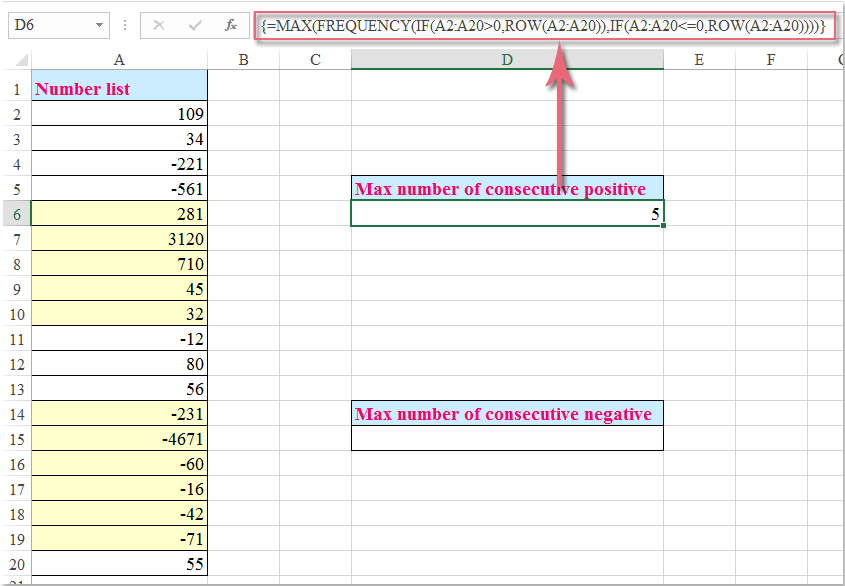Wie zählt man die maximale Anzahl aufeinanderfolgender positiver / negativer Zahlen in Excel?
Wenn Sie eine Liste mit Daten haben, die positive und negative Zahlen enthält, und Sie möchten die maximale Anzahl aufeinanderfolgender positiver und negativer Zahlen wie im folgenden Screenshot gezeigt zählen, wie könnten Sie diese Aufgabe in Excel lösen?

Zählen Sie die maximale Anzahl aufeinanderfolgender positiver und negativer Zahlen mit Array-Formeln.
Um die maximale Anzahl aufeinanderfolgender positiver und negativer Zahlen zu erhalten, wenden Sie bitte die folgenden Array-Formeln an:
Zählen Sie die maximale Anzahl aufeinanderfolgender positiver Zahlen:
Geben Sie diese Formel in eine Zelle ein, in der Sie das Ergebnis erhalten möchten:
=MAX(HÄUFIGKEIT(WENN(A2:A20>0;ZEILE(A2:A20));WENN(A2:A20<=0;ZEILE(A2:A20)))); drücken Sie dann gleichzeitig die Tasten Strg + Umschalt + Eingabe, und Sie erhalten das richtige Ergebnis, das Sie benötigen, siehe Screenshot:

Zählen Sie die maximale Anzahl aufeinanderfolgender negativer Zahlen:
Geben Sie diese Formel in eine Zelle ein, in der Sie das Ergebnis erhalten möchten:
=MAX(HÄUFIGKEIT(WENN(A2:A20<0;ZEILE(A2:A20));WENN(A2:A20>=0;ZEILE(A2:A20)))); drücken Sie dann gleichzeitig die Tasten Strg + Umschalt + Eingabe, und Sie erhalten das Ergebnis, das Sie benötigen, siehe Screenshot:

Hinweis: In den obigen Formeln ist A2:A20 der Zellbereich, den Sie verwenden möchten.

Entfesseln Sie die Magie von Excel mit Kutools AI
- Intelligente Ausführung: Führen Sie Zellenoperationen durch, analysieren Sie Daten und erstellen Sie Diagramme – alles angetrieben durch einfache Befehle.
- Benutzerdefinierte Formeln: Erstellen Sie maßgeschneiderte Formeln, um Ihre Arbeitsabläufe zu optimieren.
- VBA-Codierung: Schreiben und implementieren Sie VBA-Code mühelos.
- Formelinterpretation: Verstehen Sie komplexe Formeln mit Leichtigkeit.
- Textübersetzung: Überwinden Sie Sprachbarrieren in Ihren Tabellen.
Die besten Produktivitätstools für das Büro
Stärken Sie Ihre Excel-Fähigkeiten mit Kutools für Excel und genießen Sie Effizienz wie nie zuvor. Kutools für Excel bietet mehr als300 erweiterte Funktionen, um die Produktivität zu steigern und Zeit zu sparen. Klicken Sie hier, um die Funktion zu erhalten, die Sie am meisten benötigen...
Office Tab bringt die Tab-Oberfläche in Office und macht Ihre Arbeit wesentlich einfacher
- Aktivieren Sie die Tabulator-Bearbeitung und das Lesen in Word, Excel, PowerPoint, Publisher, Access, Visio und Project.
- Öffnen und erstellen Sie mehrere Dokumente in neuen Tabs innerhalb desselben Fensters, statt in neuen Einzelfenstern.
- Steigert Ihre Produktivität um50 % und reduziert hunderte Mausklicks täglich!
Alle Kutools-Add-Ins. Ein Installationspaket
Das Kutools for Office-Paket bündelt Add-Ins für Excel, Word, Outlook & PowerPoint sowie Office Tab Pro und ist ideal für Teams, die mit mehreren Office-Anwendungen arbeiten.
- All-in-One-Paket — Add-Ins für Excel, Word, Outlook & PowerPoint + Office Tab Pro
- Ein Installationspaket, eine Lizenz — in wenigen Minuten einsatzbereit (MSI-kompatibel)
- Besser gemeinsam — optimierte Produktivität in allen Office-Anwendungen
- 30 Tage kostenlos testen — keine Registrierung, keine Kreditkarte erforderlich
- Bestes Preis-Leistungs-Verhältnis — günstiger als Einzelkauf der Add-Ins